Anelia Angelova
Time-Scaling State-Space Models for Dense Video Captioning
Sep 03, 2025Abstract:Dense video captioning is a challenging video understanding task which aims to simultaneously segment the video into a sequence of meaningful consecutive events and to generate detailed captions to accurately describe each event. Existing methods often encounter difficulties when working with the long videos associated with dense video captioning, due to the computational complexity and memory limitations. Furthermore, traditional approaches require the entire video as input, in order to produce an answer, which precludes online processing of the video. We address these challenges by time-scaling State-Space Models (SSMs) to even longer sequences than before. Our approach, State-Space Models with Transfer State, combines both the long-sequence and recurrent properties of SSMs and addresses the main limitation of SSMs which are otherwise not able to sustain their state for very long contexts, effectively scaling SSMs further in time. The proposed model is particularly suitable for generating captions on-the-fly, in an online or streaming manner, without having to wait for the full video to be processed, which is more beneficial in practice. When applied to dense video captioning, our approach scales well with video lengths and uses 7x fewer FLOPs.
VideoComp: Advancing Fine-Grained Compositional and Temporal Alignment in Video-Text Models
Apr 10, 2025



Abstract:We introduce VideoComp, a benchmark and learning framework for advancing video-text compositionality understanding, aimed at improving vision-language models (VLMs) in fine-grained temporal alignment. Unlike existing benchmarks focused on static image-text compositionality or isolated single-event videos, our benchmark targets alignment in continuous multi-event videos. Leveraging video-text datasets with temporally localized event captions (e.g. ActivityNet-Captions, YouCook2), we construct two compositional benchmarks, ActivityNet-Comp and YouCook2-Comp. We create challenging negative samples with subtle temporal disruptions such as reordering, action word replacement, partial captioning, and combined disruptions. These benchmarks comprehensively test models' compositional sensitivity across extended, cohesive video-text sequences. To improve model performance, we propose a hierarchical pairwise preference loss that strengthens alignment with temporally accurate pairs and gradually penalizes increasingly disrupted ones, encouraging fine-grained compositional learning. To mitigate the limited availability of densely annotated video data, we introduce a pretraining strategy that concatenates short video-caption pairs to simulate multi-event sequences. We evaluate video-text foundational models and large multimodal models (LMMs) on our benchmark, identifying both strengths and areas for improvement in compositionality. Overall, our work provides a comprehensive framework for evaluating and enhancing model capabilities in achieving fine-grained, temporally coherent video-text alignment.
Whats in a Video: Factorized Autoregressive Decoding for Online Dense Video Captioning
Nov 22, 2024



Abstract:Generating automatic dense captions for videos that accurately describe their contents remains a challenging area of research. Most current models require processing the entire video at once. Instead, we propose an efficient, online approach which outputs frequent, detailed and temporally aligned captions, without access to future frames. Our model uses a novel autoregressive factorized decoding architecture, which models the sequence of visual features for each time segment, outputting localized descriptions and efficiently leverages the context from the previous video segments. This allows the model to output frequent, detailed captions to more comprehensively describe the video, according to its actual local content, rather than mimic the training data. Second, we propose an optimization for efficient training and inference, which enables scaling to longer videos. Our approach shows excellent performance compared to both offline and online methods, and uses 20\% less compute. The annotations produced are much more comprehensive and frequent, and can further be utilized in automatic video tagging and in large-scale video data harvesting.
3D Open-Vocabulary Panoptic Segmentation with 2D-3D Vision-Language Distillation
Jan 04, 2024



Abstract:3D panoptic segmentation is a challenging perception task, which aims to predict both semantic and instance annotations for 3D points in a scene. Although prior 3D panoptic segmentation approaches have achieved great performance on closed-set benchmarks, generalizing to novel categories remains an open problem. For unseen object categories, 2D open-vocabulary segmentation has achieved promising results that solely rely on frozen CLIP backbones and ensembling multiple classification outputs. However, we find that simply extending these 2D models to 3D does not achieve good performance due to poor per-mask classification quality on novel categories. In this paper, we propose the first method to tackle 3D open-vocabulary panoptic segmentation. Our model takes advantage of the fusion between learnable LiDAR features and dense frozen vision CLIP features, using a single classification head to make predictions for both base and novel classes. To further improve the classification performance on novel classes and leverage the CLIP model, we propose two novel loss functions: object-level distillation loss and voxel-level distillation loss. Our experiments on the nuScenes and SemanticKITTI datasets show that our method outperforms strong baselines by a large margin.
Mirasol3B: A Multimodal Autoregressive model for time-aligned and contextual modalities
Nov 13, 2023



Abstract:One of the main challenges of multimodal learning is the need to combine heterogeneous modalities (e.g., video, audio, text). For example, video and audio are obtained at much higher rates than text and are roughly aligned in time. They are often not synchronized with text, which comes as a global context, e.g., a title, or a description. Furthermore, video and audio inputs are of much larger volumes, and grow as the video length increases, which naturally requires more compute dedicated to these modalities and makes modeling of long-range dependencies harder. We here decouple the multimodal modeling, dividing it into separate, focused autoregressive models, processing the inputs according to the characteristics of the modalities. We propose a multimodal model, called Mirasol3B, consisting of an autoregressive component for the time-synchronized modalities (audio and video), and an autoregressive component for the context modalities which are not necessarily aligned in time but are still sequential. To address the long-sequences of the video-audio inputs, we propose to further partition the video and audio sequences in consecutive snippets and autoregressively process their representations. To that end, we propose a Combiner mechanism, which models the audio-video information jointly within a timeframe. The Combiner learns to extract audio and video features from raw spatio-temporal signals, and then learns to fuse these features producing compact but expressive representations per snippet. Our approach achieves the state-of-the-art on well established multimodal benchmarks, outperforming much larger models. It effectively addresses the high computational demand of media inputs by both learning compact representations, controlling the sequence length of the audio-video feature representations, and modeling their dependencies in time.
Detection-Oriented Image-Text Pretraining for Open-Vocabulary Detection
Sep 29, 2023



Abstract:We present a new open-vocabulary detection approach based on detection-oriented image-text pretraining to bridge the gap between image-level pretraining and open-vocabulary object detection. At the pretraining phase, we replace the commonly used classification architecture with the detector architecture, which better serves the region-level recognition needs of detection by enabling the detector heads to learn from noisy image-text pairs. Using only standard contrastive loss and no pseudo-labeling, our approach is a simple yet effective extension of the contrastive learning method to learn emergent object-semantic cues. In addition, we propose a shifted-window learning approach upon window attention to make the backbone representation more robust, translation-invariant, and less biased by the window pattern. On the popular LVIS open-vocabulary detection benchmark, our approach sets a new state of the art of 40.4 mask AP$_r$ using the common ViT-L backbone, significantly outperforming the best existing approach by +6.5 mask AP$_r$ at system level. On the COCO benchmark, we achieve very competitive 40.8 novel AP without pseudo labeling or weak supervision. In addition, we evaluate our approach on the transfer detection setup, where ours outperforms the baseline significantly. Visualization reveals emerging object locality from the pretraining recipes compared to the baseline. Code and models will be publicly released.
Contrastive Feature Masking Open-Vocabulary Vision Transformer
Sep 02, 2023



Abstract:We present Contrastive Feature Masking Vision Transformer (CFM-ViT) - an image-text pretraining methodology that achieves simultaneous learning of image- and region-level representation for open-vocabulary object detection (OVD). Our approach combines the masked autoencoder (MAE) objective into the contrastive learning objective to improve the representation for localization tasks. Unlike standard MAE, we perform reconstruction in the joint image-text embedding space, rather than the pixel space as is customary with the classical MAE method, which causes the model to better learn region-level semantics. Moreover, we introduce Positional Embedding Dropout (PED) to address scale variation between image-text pretraining and detection finetuning by randomly dropping out the positional embeddings during pretraining. PED improves detection performance and enables the use of a frozen ViT backbone as a region classifier, preventing the forgetting of open-vocabulary knowledge during detection finetuning. On LVIS open-vocabulary detection benchmark, CFM-ViT achieves a state-of-the-art 33.9 AP$r$, surpassing the best approach by 7.6 points and achieves better zero-shot detection transfer. Finally, CFM-ViT acquires strong image-level representation, outperforming the state of the art on 8 out of 12 metrics on zero-shot image-text retrieval benchmarks.
Diversifying Joint Vision-Language Tokenization Learning
Jun 15, 2023Abstract:Building joint representations across images and text is an essential step for tasks such as Visual Question Answering and Video Question Answering. In this work, we find that the representations must not only jointly capture features from both modalities but should also be diverse for better generalization performance. To this end, we propose joint vision-language representation learning by diversifying the tokenization learning process, enabling tokens that are sufficiently disentangled from each other to be learned from both modalities. We observe that our approach outperforms the baseline models in a majority of settings and is competitive with state-of-the-art methods.
Joint Adaptive Representations for Image-Language Learning
Jun 01, 2023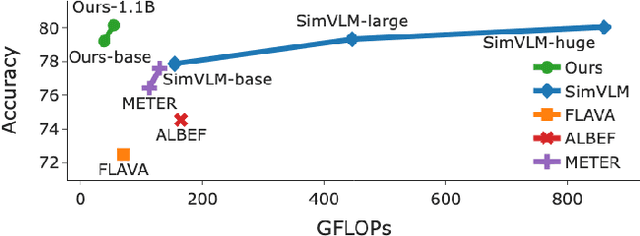
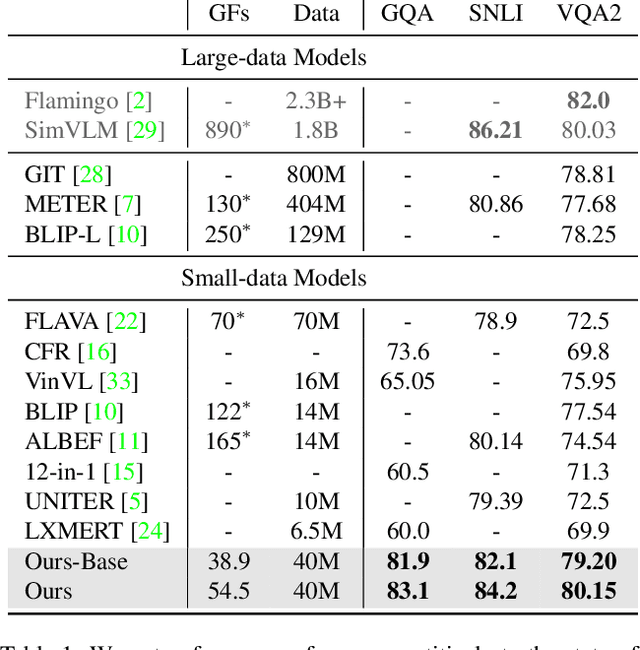
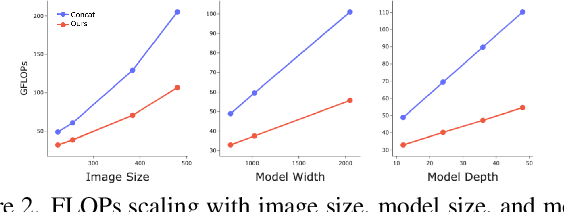

Abstract:Image-language learning has made unprecedented progress in visual understanding. These developments have come at high costs, as contemporary vision-language models require large model scales and amounts of data. We here propose a much easier recipe for image-language learning, which produces effective models, outperforming bigger and more expensive ones, often trained on orders of magnitude larger datasets. Our key finding is the joint learning of a compact vision and language representation, which adaptively and iteratively fuses the multi-modal features. This results in a more effective image-language learning, greatly lowering the FLOPs by combining and reducing the number of tokens for both text and images, e.g. a 33\% reduction in FLOPs is achieved, compared to baseline fusion techniques used by popular image-language models, while improving performance. This also allows the model to scale without a large increase in FLOPs or memory. In addition, we propose adaptive pre-training data sampling which improves the data efficiency. The proposed approach achieves competitive performance compared to much larger models, and does so with significantly less data and FLOPs. With only 40M training examples and with 39 GFLOPs our lightweight model outperforms many times larger state-of-the-art models of 2-20x more FLOPs and using bigger datasets some of which with close to 1B training examples.
PaLI-X: On Scaling up a Multilingual Vision and Language Model
May 29, 2023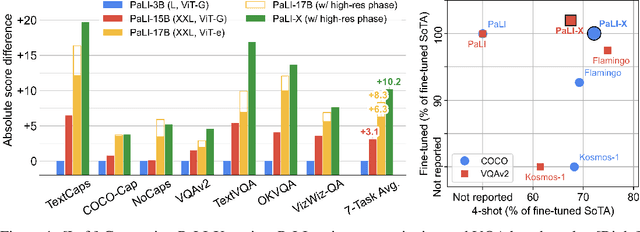

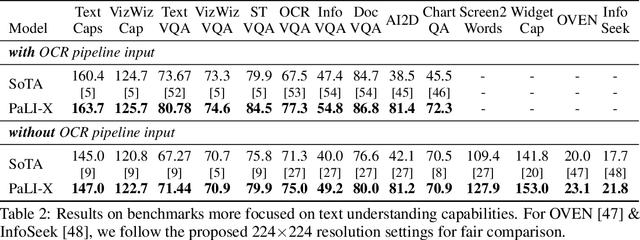
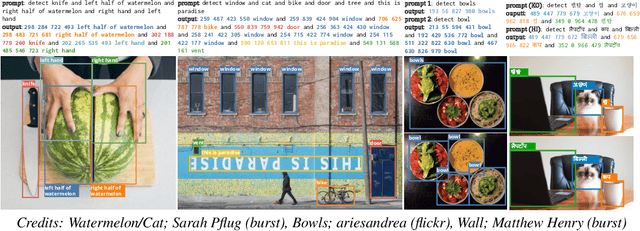
Abstract:We present the training recipe and results of scaling up PaLI-X, a multilingual vision and language model, both in terms of size of the components and the breadth of its training task mixture. Our model achieves new levels of performance on a wide-range of varied and complex tasks, including multiple image-based captioning and question-answering tasks, image-based document understanding and few-shot (in-context) learning, as well as object detection, video question answering, and video captioning. PaLI-X advances the state-of-the-art on most vision-and-language benchmarks considered (25+ of them). Finally, we observe emerging capabilities, such as complex counting and multilingual object detection, tasks that are not explicitly in the training mix.
 Add to Chrome
Add to Chrome Add to Firefox
Add to Firefox Add to Edge
Add to Edge